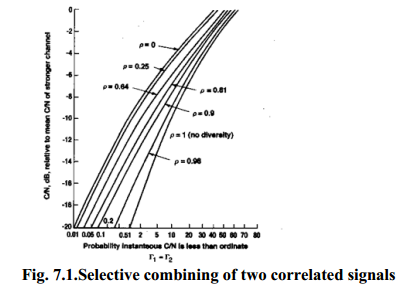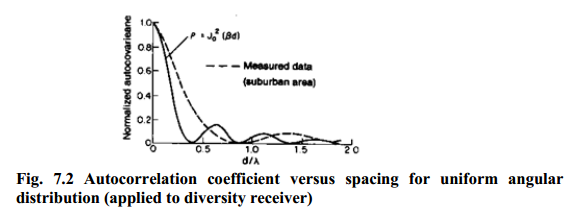Discuss the diversity schemes for interference reductions at both mobile unit and cell site
7. Discuss the diversity schemes for interference reductions at both mobile unit and cell site.
Diversity Receiver: The diversity scheme applied at the receiving end of the antenna is an effective technique for reducing interference because any measures taken at the receiving end to improve signal performance will not cause additional interference. The diversity scheme is one of these approaches. We may use a selective combiner to combine two correlated signals as shown in Fig. 7.1. The performance of other kinds of combiners can be at most 2 dB better than that of selective combiners. However, the selective combining technique is the easiest scheme to use.
Figure 7 shows a family of curves representing this selective combination. Each curve has an associated correlation coefficient p; when using the diversity scheme, the optimum result is obtained when p = 0.
We have found that at the cell site the correlation coefficient p < 0.7 should be used for a twobranch space diversity; with this coefficient the separation of two antennas at the cell site meets the requirement of h / d= 11, where h is the antenna height and d is the antenna separation.
 |
| Selective combining of two correlated signals |
At the mobile unit we can use p =0, which implies that the two roof-mounted antennas of the mobile unit are 0.5 Lambda or more apart. This is verified by the measured data shown in Fig. 7.2. Now we may estimate the advantage of using diversity. First, let us assume a threshold level of 10 dB below the average power level.
 |
| Auto correlation coefficient versus spacing for uniform angular distribution (applied to diversity receiver) |
Then compare the percent of signal below the threshold level both with and without a diversity scheme.
1. At the mobile unit: The comparison is between curves p = 0 and the p=1. The signal below the threshold level is 10 percent for no diversity and 1 percent for diversity. If the signal without diversity were 1 percent below the threshold, the power would be increased by 10 dB. In other words, if the diversity scheme is used, the power can be reduced by 10 dB and the same performance can be obtained as in the non diversity scheme. With 10 dB less power transmitted at the cell site, cochannel interference can be drastically reduced.
2. At the cell site: The comparison is between curves of p=0.7 and p =1. We use curve p=0.64 for a close approximation as shown in Fig. 7.1. The difference is 10 percent of the signal is below threshold level when a non diversity scheme is used versus 2 percent signal below threshold level when a diversity scheme is used. If the non diversity signal were 2 percent below the threshold, the power would have to increase by 7 dB (see Fig.7.1). Therefore, the mobile transmitter (for a cell-site diversity receiver) could undergo a 7dB reduction in power and attain the same performance as a non diversity receiver at the cell site. Thus, interference from the mobile transmitters to the receivers can be drastically reduced.

